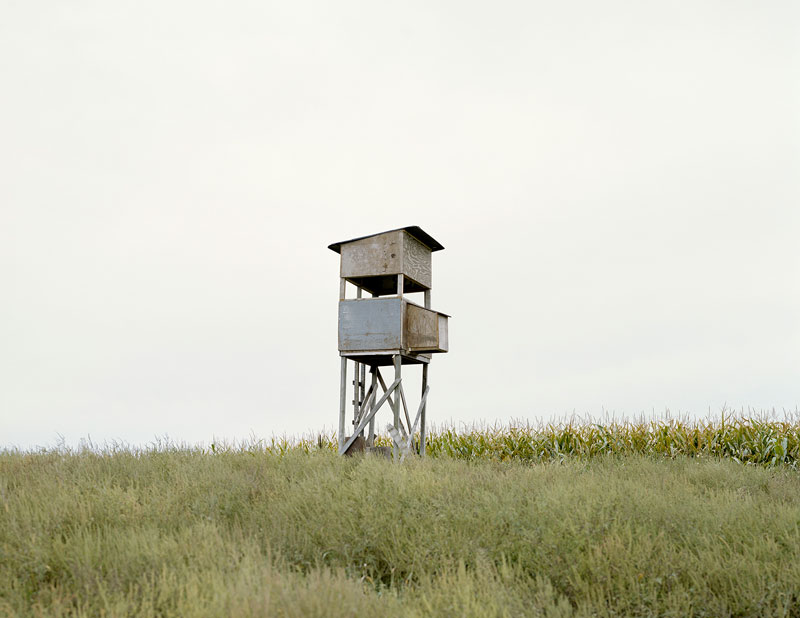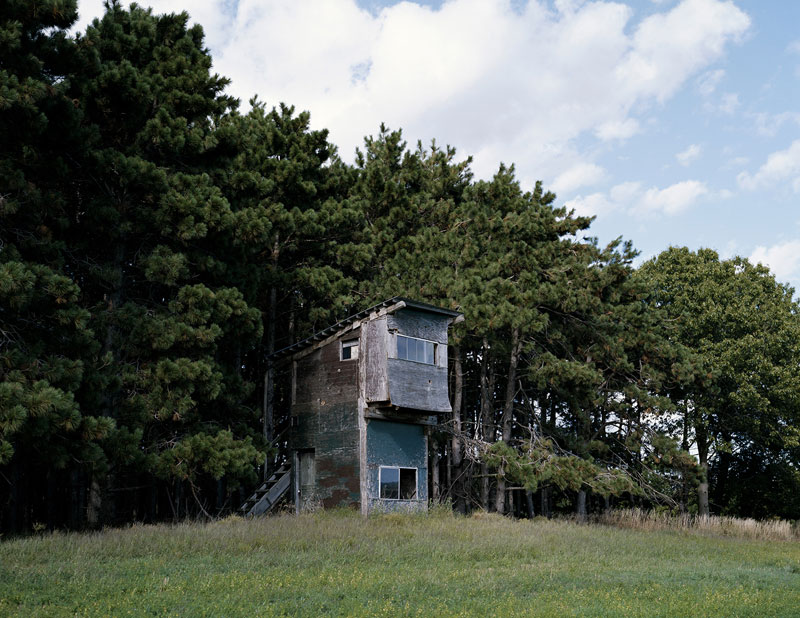

Portage (2), WI, Archival Pigment Print, 2012
hide was intended to be a simple typological reflection on Wisconsin’s hunting tradition, using deer stands as the visual motif. When my sudden cancer diagnosis interrupted the project, hide took on a much deeper, more personal meaning.
I was born in northern California, and was raised in a family with no tradition of hunting or guns. When I met my wife, I began coming to her family’s Christmas celebrations in Wisconsin and was inspired by the deer stands we passed on the drive from the Madison airport into rural Wisconsin. They were strange structures that loomed proudly on the horizon, or skulked sneakily along the tree-line. I did not know what these simple structures were used for, but I was intrigued. One Christmas, my wife’s uncle started telling me about his plans to fix a deer stand on his property with his son. I finally learned what a deer stand was, though admittedly I was turned off by the idea – I am an animal lover at heart and bristled at the thought of shooting a deer.
They were strange structures that loomed proudly on the horizon, or skulked sneakily along the tree-line.
In fact, I can distinctly remember my first exposure to hunting, as a child in my small hometown of Sonora, CA. A hunter had mounted a recently shot deer on his front hood and was parading it proudly through town. My mild-mannered mother drove after the man and screamed obscenities at him through our car window. The hatred of hunting was thus ingrained in my mind.


Portage, WI
Archival Pigment Print
2013


Forest, WI
Archival Pigment Print
2013
But as I explored hide my perspective on hunting changed. I began having conversations with hunters about their families’ traditions surrounding hunting. Some people described building the stands as something permanent to pass onto the next generation, especially sons who would inherit the land. I was anticipating the birth of my own son and thinking about my legacy to him, so this notion resonated strongly with me. The hunters also emphasized their pastime is not about violence, but about oneness with nature and time with their children in the stands.
Part of my hope for hide is that it begins a dialogue. In talking with the owners of these stands, I have become more open-minded about the idea of hunting. Hunters speak with nostalgia about cold days in the deer stands with their fathers. They do not quickly bring up the animals or the idea of death; instead, they speak about a kind of camaraderie that I find entirely compelling. Countless times, complete strangers have invited me on hunting trips. Despite my initial distaste, I am seeing hunting in a different way.
Nothing will bring about a truce between animal activists and sport hunters. Nonetheless, I wanted these photographs to capture the serenity of a quiet afternoon of family bonding, and to suggest the dignity that was associated with hunting when it was seen as a means of feeding large families. Part of my own changing perception was realizing the hypocrisy of eating meat while judging hunters. Perhaps hunters are more humane than I am: They get their meat from nature where the animals are not caged or force-fed.
Part of my own changing perception was realizing the hypocrisy of eating meat while judging hunters. Perhaps hunters are more humane than I am: They get their meat from nature where the animals are not caged or force-fed.


Portage (4), WI
Archival Pigment Print
2012
Finally, I wanted to look at the issue from a historical standpoint, and the impermanent nature of some stands illustrates the fading hunting tradition in Wisconsin. I suppose every generation laments the loss of its customs, and as I spoke with hunters in their 40s, I often heard regret that their children would rather spend time on a computer than an afternoon in a cold deer stand. As a parent, I began to appreciate the idea that your children will not always share your interests, and you have to meet them where they are.
All of this brings me to the idea of family, which ultimately became the most important theme in hide. When I was diagnosed with Leukemia in 2011, my work on hide was put on hold. I was 32 years old, had a 3-month-old baby at home, and had just moved to Wisconsin where my wife was starting medical school. I remember being diagnosed. It was the day after my son’s first Thanksgiving. My wife took him home to pack a bag, and they slept on a recliner in my hospital room for the next month. I went through physical hell, compounded by an existential crisis. I took comfort in the fact that my son was too young to remember any of it – me losing my hair, being too frail to walk the hallways, instructed by doctors not to touch him because of the poisonous drugs in my body.


Two Creeks, WI
Archival Pigment Print
2013
I went home a few days before Christmas, and had “consolidation chemotherapy” over the next four months. Every time I started to feel well, I had another injection and started the whole cycle again. I did not have enough strength to carry my large format camera. And, to be honest, I lost most of my motivation. There were times I thought I might never photograph again.
In the late spring, I experienced whole days of feeling well and came back to the project with a new perspective on the ideas of permanence and impermanence, mortality and immortality, family and connection. During my treatment, I realized that some of my closest friendships, which I thought would be permanent parts of my life, were actually very flimsy. My friends faltered in the face of illness and that eerie quality of a body at war with itself. My wife was immersed in medical school and I often felt lonely. hide became a kind of mental and physical therapy for me. Talks with the hunters were my main connection to other adults. My walks to the stands through large fields and green pastures were a distraction from thinking about cancer. In many ways, hide rescued my sanity.
The further I get into remission – and from painful memories of my illness – the closer I get to the photographs, and to seeing qualities beyond solitude, sadness, and silence. Lately, I look at the images and experience a new emotion: grace. Ultimately, hide became my reflection on legacies and family, my homage to the state that has become my home, and a subconscious narrative about accepting change and loss, gracefully.


Columbus, WI
Archival Pigment Print
2014